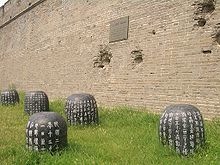I hear of Confucius and Confucianism and wonder, "Is he a deity and is it a religion?" of "Is he a man and a doctrine?" Well, in my limited understanding of Asian/Chinese history, and in talking with my colleague Mr. P-C, it's the latter. Confucius (born 551BC) came up with a set of principles based on humanism, etiquette, filial piety, loyalty, knowledge and integrity, that ended up being the basis of the Chinese political system until the early 1900's. To get into government service, one had to pass Confucian exams, essentially being able to memorize and analyze Confucian thought and ideas. I wondered whether or not it was the most effective way to find the best people. I thought maybe, but as P-C so succinctly put it, "it is like trying to staff a government that needs administrators and bureaucrats with only people who could successfully get a PHD in English." Point taken!
That all being said, it's now Chinese New Year's week vacation and I decided to take a day trip to Qufu, where Confucius was born to see the large temple there. I took some students along as well!
 |
| "Qufu" |
 |
| "Kong Zi" |
 |
| Southern Entrance into The Confucius Temple at Qufu |
 |
| Started 2500 years ago as a place for quiet contemplation, it has grown into a smaller version of The Forbidden City. The grounds have temples and courtyards that are filled with "Stele Pavilions" |
 |
| On the right, one of my students with whom I have a running gag. We play the "bowing game" and the winner is the one who goes last. |
 |
| She has incredible patience and ALWAYS wins. |
 |
| A few kilometers north of the temple is the Kong Family Cemetery. Here's the entrance. |
 |
| The gravestone of Confucius himself! |
 |
| Apparently, he's buried under the mound behind me. |
 |
| Grave of the son of Confucius |
 |
| Grave of the grandson of Confucius |
 |
| The cemetery has over 100,000 graves. All descendents of "Kong Zi" The cemetery now is 3.6 square kilometers. |
 |
| In fact, family members are still being buried here, this one, if I'm reading it right, was placed here in 2004. In fact, descendants of the 78th generation are being buried here. |
 |
| The Kong Family cemetery in Qufu is the cemetery that has the longest direct lineage to one person in the entire world. That's pretty cool! |
 |
| On the bus back to the train station, your typical announcements about the next stop and then, at the end, "The Diaoyu Islands belong to China!" |




















































